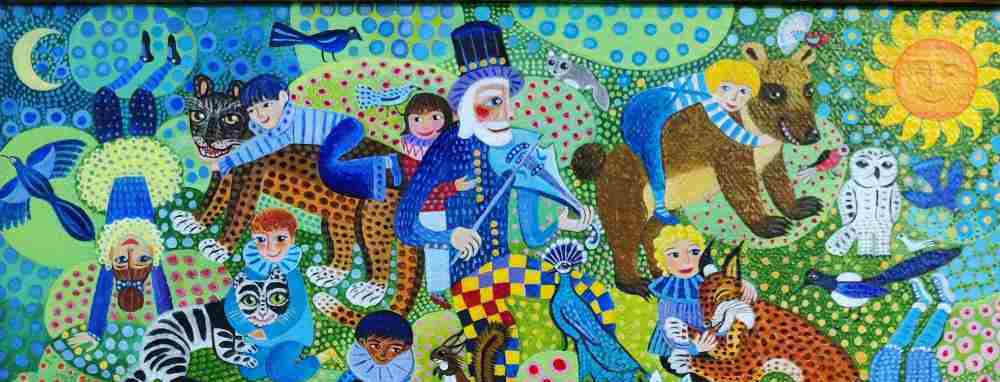Animals Taking Care of People’s Affairs
Kikka Nyrén
Kikka started drawing when she was one year old – elves with red caps were her first subjects. Dad painted advertising pictures in the same room where Kikka and her sister slept in a bunk bed behind a ship curtain. The family lived in an old villa with a mansard roof on Tapanila Puutarhatie. There was plenty of paper and pencils for the diligent artists, and mom and dad praised and encouraged them. At school, she looked forward to art lessons and doesn’t remember thinking of them as lessons at all.
Kikka started illustration work when she was a student. As a young adult, she and her family moved to Suonenjoki to grow sheep and strawberries. There, Kikka did illustration work for many publishing houses. In the 1990s, during the recession, Kikka moved with her family to Mikkeli, where she attended several art courses. The studies of drawing and painting began at the Open University of the School of Art and Design.
The basic studies in art helped to solve practical problems, the work became more diverse, the outlook for the future opened up, courage and self-confidence strengthened with the skills. There were many masters to admire in the art of painting – from cave paintings and Cretan small sculptures through medieval church sculptures and tapestries to the Dutch pre-naivists, French naivists and Russian modern naivists. She found her own style in naivety. The turning point in the path in the jungle of art was the teaching of the sculptor Taisto Rauta, and in 2000, at the age of 49, Kikka dared to hold her first own exhibition at the Veturitorn Gallery in Heinola.
From the beginning, the topics have been man’s relationship with nature and animals, ”our brothers”. Kikka also paints small town and village landscapes, but most often we are in an unbuilt environment, a park, a beach, a meadow or a jungle. The subject can be, for example, a park party.
I want the people and animals in my paintings to have a good time and have fun. But every picture should also have something refractory – someone sulking, whining, sad or helpless.
Kikka uses pure colours and wants her work to glow on a canvas primed with linen. She doesn’t make sketches, but the painting develops while doing it and the stories happen almost by themselves. This is how the work progresses in the funniest and best way, but not always everything goes smoothly. Then she grabs another unfinished painting and leaves the stalled work waiting. If possible, she paints every day, in the study of her own home on the sixth floor in Lahti.
The longest and most persistent supporter has been Kikka’s husband Aimo, who understood that the living room must be converted into a studio. In winter, there must be decent lighting with natural light, while in summer, Venetian blinds smooth out too bright sunlight.
Kikka uses colours boldly ignoring rules about the compatibility or incompatibility. Maybe it’s an indication of the artist’s good routine and scarce colour scale. She starts by painting the base colour on the canvas, then the big things in place, houses, trees, riverside or mountains. Then it’s the turn of human figures and animals from the biggest to the smallest. As the painting progresses, she removes things and adds others. In Kikka’s opinion, there must be many layers of colours so that the material can be seen in the finished work. Colours affect each other – opposite colours make each other glow. Details are important to her. Kikka has missed some of the sold works, but the longing has passed. Every purchase made by an art lover has been a source of joy in the end.
Kikka says that the work is only finished when the last point of light, spot of colour, flower petals, cat’s whisker hairs are in place and the figures are precisely defined. It cannot be done without professional tools, i.e. richly pigmented acrylic paints and French quill brushes, a properly primed linen base, which a skilled framer has attached to the wedge frames. When the painting is finished, a suitable frame is selected at the frame shop to complete the work.
Kikka’s ceramics are also colourful. The first ceramic works were cat head reliefs. Recently she has made less ceramics due to lack of time and studio problems. However, she still believes that she will return to working with clay because she misses it. Kikka shapes everything by hand, and the subjects come from her imagination, just like the subjects of her paintings. In addition to glazing, she uses gold leaf, glass beads and other ”little treasures” for ceramic sculptures.
Over the years, Kikka has participated in exhibitions and galleries in various parts of Finland: in Varkaus, Iittala, Oulu, Jyväskylä, Heinola, Kouvola, Lapua, Alavus and Helsinki.
She has also participated in foreign festivals and exhibitions – in Poland, Estonia, Israel, Belgium, Slovakia, Romania, Slovenia, Germany, Brazil, France and the Czech Republic.
It is said that a work of art is only finished when it gets an audience. That’s why exhibitions are important. I am happy that my art has found friends. The image is an ancient and strong influencer. With my own art, I want to move and delight the viewer of my paintings and sculptures. That’s how an invisible connection is created between us who don’t know each other.

